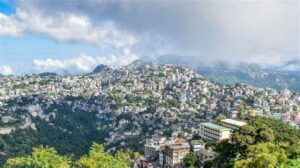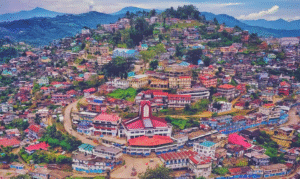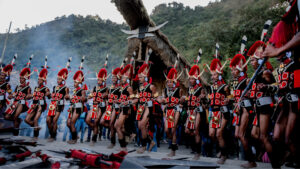In the vast tapestry of Indian culture, where legends are often born from ancient myths and epic tales, there emerges a figure whose life and art were a living testament to the power of human connection, social conscience, and the timeless beauty of folk traditions. Dr. Bhupen Hazarika, affectionately known as the ‘Bard of Brahmaputra’ or ‘Sudhakantha’ (the nectar-throated), was more than just a singer, composer, or filmmaker. He was a cultural bridge-builder, a philosopher in song, and a humanist whose melodies transcended borders and touched the very soul of humanity.
Born amidst the serene landscapes of Sadiya, Assam, along the majestic Brahmaputra river, Hazarika’s journey was a profound exploration of identity, justice, and the universal yearning for belonging. This blog delves into the multi-faceted genius of Dr. Bhupen Hazarika, examining how he seamlessly blended the rustic charm of Assamese folk sensibilities with profound global themes, leaving an indelible mark on the cultural consciousness of India and beyond.
A Prodigy’s Dawn: The Brahmaputra’s First Echoes
Our story begins in 1926, in the sleepy town of Sadiya, nestled beside the vast, meandering Brahmaputra. Here, a young Bhupen was immersed in the rich oral traditions and folk melodies that permeated the Assamese air. His mother, a repository of folk songs and lullabies, was his first guru, gently guiding his innate musicality. The river, a silent witness to his childhood, would later become a recurring motif in his compositions – a symbol of life, resilience, and flow.
The brilliance of his talent, however, was too immense to remain confined to Sadiya. At a tender age of ten, Hazarika stunned audiences by performing a Borgeet (classical Assamese devotional song) and, by twelve, he had recorded his first song. It was during this period that the luminaries of Assamese culture, Jyotiprasad Agarwala and Bishnu Prasad Rabha, recognized the spark of genius. They became his early mentors, nurturing his artistic inclinations and setting him on a path that would redefine Indian music and cinema. Imagine a young boy, barely a teenager, already possessing a voice that hinted at the profound depths it would later explore.
The Global Sojourn: Paul Robeson and the Genesis of Universalism
While his roots were firmly planted in the red soil of Assam, Dr. Hazarika’s intellectual and artistic horizons expanded dramatically during his academic pursuits. After completing his Master’s in Political Science from Banaras Hindu University, a pivotal chapter of his life unfolded in the bustling metropolis of New York, where he pursued a Ph.D. in Mass Communication from Columbia University in the late 1940s.
It was here, amidst the vibrant intellectual milieu of post-war America, that a profound encounter shaped the very core of his philosophy. He met and was deeply influenced by Paul Robeson, the legendary African-American singer, actor, and civil rights activist. Robeson’s powerful rendition of “Ol’ Man River,” a poignant lament against racial injustice and the relentless passage of time, resonated deeply with Hazarika. This encounter was transformative. Hazarika realized that art was not merely for entertainment; it was a potent instrument for social commentary, a voice for the voiceless, and a tool for change.
This epiphany gave birth to “Bistirno Parore” (meaning ‘On the vast banks’), famously adapted in Hindi as “O Ganga Behti Ho Kyun.” This seminal song, a philosophical dialogue with the mighty river, lamented human suffering, war, and conflict, urging the river to carry messages of peace and harmony. It was a direct lyrical homage to Robeson’s “Ol’ Man River,” but imbued with the spirit of the Brahmaputra and the universal plea for human dignity. This period in New York was crucial; it solidified Hazarika’s conviction that while his art would speak of his homeland, its message would be unequivocally universal.
The Symphony of Humanity: Hazarika’s Musical Odyssey
To speak of Dr. Bhupen Hazarika’s music is to speak of a vast, flowing river itself, encompassing myriad emotions, stories, and philosophies. His unique baritone voice, rich and resonant, became his signature, capable of conveying both profound sorrow and soaring hope.
A Fusion of Worlds: Hazarika was a master of fusion, long before the term became commonplace. He seamlessly wove together the intricate threads of traditional Assamese folk music—Bihu’s celebratory rhythms, the devotional depth of Borgeet, and the soulful laments of Goalparia folk—with classical Indian melodies, and even Western influences from his time in America. His orchestrations were inventive, giving his compositions a unique texture that was both deeply rooted and globally resonant.
Lyrics That Echo Life: But it was in his lyrics that Hazarika truly shone as a philosopher. He spoke not just of Assam, but of humanity.
- “Manuhe Manuhor Babe” (Humans for Humanity): This song became an anthem of universal brotherhood, urging people to stand for one another, transcending artificial divisions of caste, creed, and nationality. It was a simple yet profound plea for empathy in a fractured world.
- “Moi Eti Jajabor” (I am a Wanderer): This autobiographical song encapsulated his life’s journey, a nomadic quest for knowledge and understanding, connecting with people across various lands and cultures. It celebrated the spirit of exploration and shared human experience.
- Social Conscience: Hazarika wielded his music as a powerful instrument for social justice. He sang of the plight of farmers, the struggles of the working class, and the communal disharmony that periodically plagued his beloved Assam. His songs were often direct, unflinching critiques of injustice, designed to awaken the collective conscience.
- The Brahmaputra as Muse: The river was a constant presence in his work, not just as a geographical feature, but as a living entity, a metaphor for life’s journey, societal changes, and eternal truths. His deep reverence for the natural beauty of Assam was intertwined with his humanist themes, grounding his universal messages in a strong regional identity.
His linguistic versatility was another testament to his unifying vision. Fluent in Assamese, Bengali, and Hindi, he composed and sang in all three languages, extending the reach of his profound messages to diverse audiences across the Indian subcontinent.
The Visionary Auteur: Crafting Stories on Celluloid
Dr. Bhupen Hazarika’s genius was not confined to sound waves; it extended to the visual medium of cinema, where he emerged as a pioneering force in Assamese filmmaking. His journey into cinema began early, as a music director, but he soon transitioned to directing and producing, using the screen as another canvas for his social narratives.
Films like Shakuntala, Pratidhwani, and Loti Ghoti showcased his storytelling prowess, often focusing on social issues, rural life, and the unique cultural tapestry of Assam. He received multiple National Film Awards for both his direction and music, cementing his place as a versatile artist.
Perhaps his most significant cinematic contribution, however, was his role in bridging the cultural divide between the Northeast and mainstream Indian cinema. His musical compositions for acclaimed Hindi films like Rudaali, Ek Pal, and Darmiyaan introduced the unique sounds and lyrical depth of the region to a national audience. Who can forget the haunting melody of “Dil Hoom Hoom Kare” from Rudaali, sung in his inimitable voice, which became an iconic representation of his ability to evoke profound emotion across linguistic barriers? He also played a crucial role in establishing Assam’s first state-owned film studio in Guwahati, a lasting legacy for the region’s cinematic aspirations.
His commitment to promoting indigenous cultures extended even further with “Mera Dharam Meri Maa,” the first Hindi feature film in color produced in Arunachal Pradesh, showcasing his unwavering dedication to the diverse tribal cultures of the Northeast.
The Pen and the Platform: A Public Intellectual
Beyond the stage and the silver screen, Dr. Hazarika was a prolific writer and an engaged public intellectual. His literary output was extensive, encompassing over 15 major books, including poignant short stories, insightful essays, captivating travelogues, and even delightful children’s rhymes. His writings, much like his songs, were infused with his humanist philosophy, reflecting on society, culture, and the human condition.
He also utilized journalism as a platform for public discourse, serving as editor for popular monthlies like Amar Pratinidhi and Pratidhwani. Through these publications, he engaged with socio-political issues, voicing his opinions and contributing to the intellectual ferment of his time. Even his brief stint as an Independent MLA (1967-72) and later political involvement stemmed from his core conviction: art and public service were inextricably linked in the pursuit of social betterment and human welfare. His political actions, therefore, were extensions of his philosophical and artistic commitments.
The Enduring Legacy: A River of Inspiration
Dr. Bhupen Hazarika passed away in 2011, but his voice, his vision, and his values continue to echo through the valleys and plains he loved so dearly. He remains the undisputed “Bard of Brahmaputra,” a cultural ambassador who introduced the rich artistic traditions of Assam and the wider Northeast to national and international prominence.
His numerous accolades, including the Padma Shri (1977), Padma Bhushan (2001), the Dada Saheb Phalke Award (1992) – India’s highest film honor – and the Sangeet Natak Akademi Award (1987) and Fellowship (2008), are testaments to his colossal contributions. The posthumous Bharat Ratna (2019), India’s highest civilian award, cemented his place as one of the nation’s most revered figures.
Bhupen Hazarika’s influence continues to inspire generations of musicians, filmmakers, writers, and social activists. His songs, timeless in their relevance, serve as anthems of hope, protest, and unity, reminding us that despite our differences, we are all part of the same human family, flowing like the mighty Brahmaputra towards a shared destiny. He didn’t just sing about rivers; he was a river – ever-flowing, nurturing, and connecting. His legacy is not just a collection of songs and films, but a profound philosophy of life that continues to resonate, urging us to embrace our shared humanity, one melodic note at a time.






